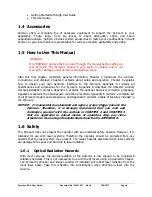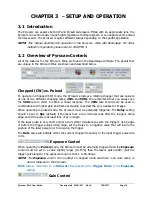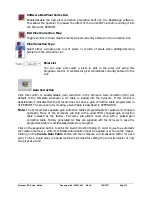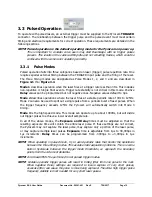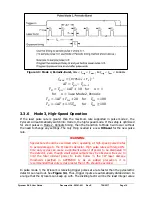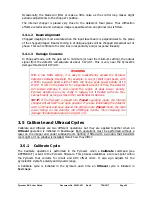
Pyrocam III
HR
User Guide
Document No. 50361-001
Rev E
7/18/2017
Page 16
3.3.2
Pulse Mode Setup Procedure
Pulse mode is enabled by selecting
Pulsed
in the
Trigger Method
panel. Connect a trigger
source to the TRIGGER connector. See APPENDIX A for trigger pulse electrical requirements.
The GREEN
Trigger
LED will illuminate when trigger pulses are applied to the Pyrocam. The
RED LED will blink once when power is applied. It will not blink again unless an error has
occurred in the firmware.
NOTE:
Pulsed operation is the default operating mode for the Pyrocam on power up
.
This is important to consider since users may start BeamGage with no trigger pulses
present. This results in the camera sitting idle and not collecting frames, which could be
confused with the camera not operating correctly.
The
Delay
setting is adjusted based on the selected operating mode and is described in the
following Mode descriptions.
3.3.2.1
Trigger Rate Stability
Trigger rate stability is required for pulsed modes 2 and 3. For best results, the trigger pulse
repetition rate should be stable to within ±200µs. The Pyrocam will monitor the current
trigger rate and compare it to the rate recorded during the last
Ultracal
cycle. The
Ultracal
status bar indicator
will change from GREEN to RED
if the trigger rate
changes significantly from the rate used during the
Ultracal
cycle. This change to RED will
revert to GREEN if the previous trigger rate is restored.
The following notations are used in the timing diagrams and equations:
𝑓
𝑡𝑟𝑖𝑔
= 𝑡𝑟𝑖𝑔𝑔𝑒𝑟 𝑝𝑢𝑙𝑠𝑒 𝑓𝑟𝑒𝑞𝑢𝑒𝑛𝑐𝑦 (𝐻𝑧)
𝑓
𝑝𝑢𝑙
= 𝑙𝑎𝑠𝑒𝑟 𝑝𝑢𝑙𝑠𝑒 𝑓𝑟𝑒𝑞𝑢𝑒𝑛𝑐𝑦 (𝐻𝑧)
𝑓
𝑏𝑢𝑟
= 𝑙𝑎𝑠𝑒𝑟 𝑝𝑢𝑙𝑠𝑒 𝑏𝑢𝑟𝑠𝑡 𝑓𝑟𝑒𝑞𝑢𝑒𝑛𝑐𝑦 (𝐻𝑧)
𝑓
𝑝𝑠𝑟
= 𝑙𝑎𝑠𝑒𝑟 𝑝𝑢𝑙𝑠𝑒 𝑠𝑎𝑚𝑝𝑙𝑒 𝑟𝑎𝑡𝑒 (𝐻𝑧)
𝑓
𝑚𝑎𝑥
= 𝑚𝑎𝑥 𝑝𝑢𝑙𝑠𝑒 𝑐𝑎𝑝𝑡𝑢𝑟𝑒 𝑟𝑎𝑡𝑒 (𝐻𝑧)
𝑇
𝐷
= 𝐷𝑒𝑙𝑎𝑦
(program in Trigger Method)
𝑇
𝐸
= 𝐸𝑥𝑝𝑜𝑠𝑢𝑟𝑒
(program in Exposure|Gain)
𝑇
𝑡𝑤
= 𝑡𝑟𝑖𝑔𝑔𝑒𝑟 𝑝𝑢𝑙𝑠𝑒 𝑤𝑖𝑑𝑡ℎ
𝑇
𝑡𝑝
= 𝑡𝑟𝑖𝑔𝑔𝑒𝑟 𝑝𝑒𝑟𝑖𝑜𝑑
𝑇
𝑡𝑗
= 𝑡𝑟𝑖𝑔𝑔𝑒𝑟 𝑗𝑖𝑡𝑡𝑒𝑟
𝑇
𝑙𝑤
= 𝐿𝑎𝑠𝑒𝑟 𝑝𝑢𝑙𝑠𝑒 𝑤𝑖𝑑𝑡ℎ
∆𝑇 = 𝐿𝑎𝑠𝑒𝑟 𝑝𝑢𝑙𝑠𝑒 𝑝𝑒𝑟𝑖𝑜𝑑
𝑇
𝑟
= 𝑟𝑒𝑠𝑝𝑜𝑛𝑠𝑒 𝑑𝑒𝑙𝑎𝑦
(All times are in µsec unless noted otherwise)
3.3.3
Mode 1, Single-Shot Operation
Mode 1 describes operation when the laser fires at a trigger rate of <3Hz, including non-
repetitive or Single-Shot triggers.
diagrams the trigger timing requirements for
this mode of operation. In this mode, the laser must fire within an exposure time window that
begins 10µs after the rising edge of the applied trigger. The entire laser pulse duration must





